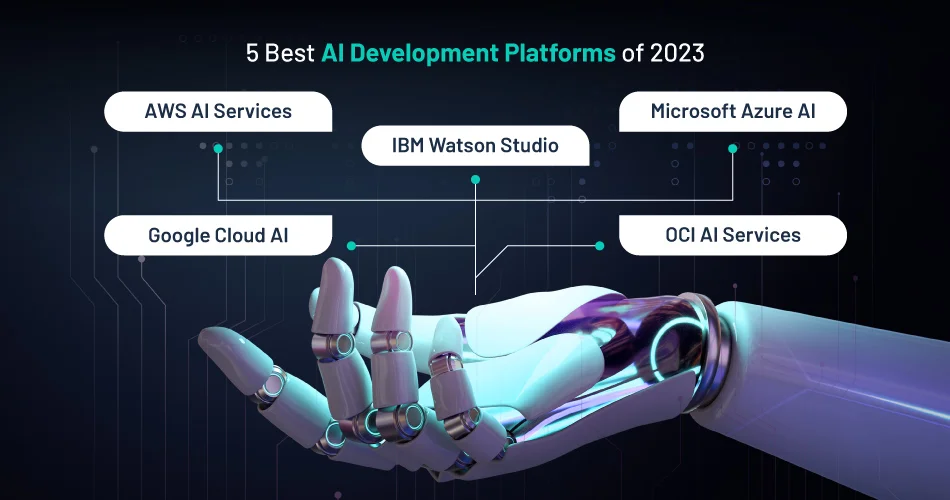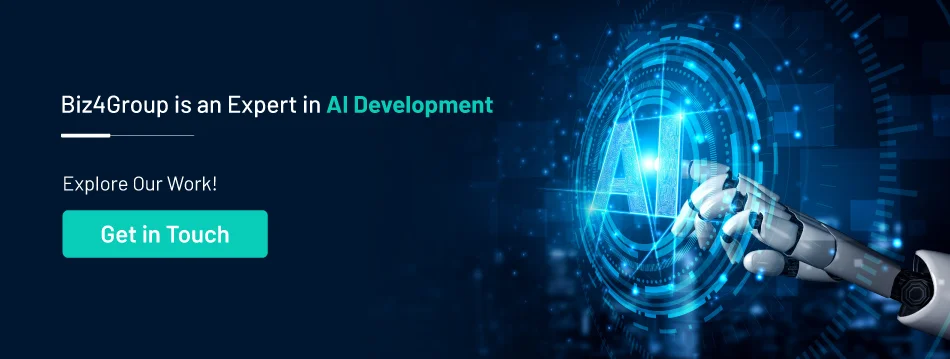Top 5 AI Development Platforms of 2023
- The global AI market will reach $407 billion by 2027. It’ll grow at a CAGR of 36.2%.
- By 2030, one in ten cars will be self-driving.
- 64% of businesses expect AI to improve their productivity.
Be it customers getting personalized shopping suggestions or someone talking to a chatbot, AI is everywhere.
It is true that businesses need AI more than ever. However, developing AI solutions require deep research in terms of picking the right platform and business case. Many organizations struggle while strategizing AI roadmap while others find it challenging to pick the right AI platform.
We’ll keep the AI strategy for another blog post. For now, let’s focus on picking the right AI platform. We’ll begin with the basics.
What are AI Development Platforms?
An AI development platform serves as a comprehensive solution, offering a range of tools and interfaces to enable data scientists, IT professionals, and even non-technical business personnel to develop AI-powered applications.
These platforms are primarily accessible through the cloud, although some also offer support for on-premises and hybrid setups. They come equipped with essential features like automated machine learning (autoML) capabilities, as well as natural language and vision processing functionalities.
Let’s find out the top 5 that you can consider for your AI strategy.
5 Best AI Development Platform of 2023
We have utilized various online sources, including Gartner's Magic Quadrant and peer insights publications, as well as customer reviews from G2, to rank these platforms.

1. AWS AI Services
AWS (Amazon Web Services) offers a comprehensive suite of AI and ML services, supported by a robust cloud infrastructure. These pre-trained services provide ready-made intelligence for applications, seamlessly integrating with common use cases like personalized recommendations, contact center modernization, safety enhancements, and customer engagement.
Here are the top AI and ML services AWS offers:
- AWS AI services cover computer vision, data analysis, language processing, customer experience, business metrics, DevOps, industrial AI, and healthcare.
- Amazon SageMaker is an end-to-end ML service, that provides managed infrastructure and tools for quick development, training, and deployment of ML models.
- AWS Panorama brings computer vision to on-premises cameras, enabling accurate local predictions.
- Amazon Augmented AI (A2I) simplifies human review workflows and can be used alongside services like Rekognition, Textract, and Comprehend.
With the broadest range of ML services and cloud support, AWS democratizes machine learning for developers, data scientists, and practitioners. It assists thousands of customers in their ML journey and also offers free services such as text-to-speech, speech-to-text, ML, and translation.

2. Microsoft Azure AI
- AI Platform is a fast, scalable, and easy-to-use AI offering that includes video and image analysis, speech recognition, and multi-language processing. It allows users to train models using a wide range of different customization options and select many different machine types. AI Platform supports Kubeflow, which lets users build portable ML pipelines that can be run on-premises or on Google Cloud Platform without significant code changes.
- Azure Cognitive Services brings AI within reach of every developer and data scientist. It offers APIs that don't require machine-learning expertise and enables developers and data scientists of all skill levels to easily add AI capabilities to their apps. Azure Cognitive Services provides leading models and a variety of use cases that can be unlocked with an API call to embed the ability to see, hear, speak, search, understand, and accelerate advanced decision-making into your apps.
- Azure Machine Learning empowers data scientists and developers to build, deploy, and manage high-quality models faster and with confidence. It accelerates time to value with industry-leading machine learning operations (MLOps), open-source interoperability, and integrated tools. Azure Machine Learning is designed for responsible AI applications in machine learning and offers a managed end-to-end platform that streamlines the entire deep-learning lifecycle and model management with native MLOps capabilities.
- Azure Cognitive Service for Vision is a unified service that offers innovative computer vision capabilities. It provides the ability to analyze images, read text, and detect faces with prebuilt image tagging, text extraction with optical character recognition (OCR), and responsible facial recognition. Azure Cognitive Service for Vision is designed to elevate your computer vision projects and incorporates vision features into your projects with no machine learning experience required.
3. Google Cloud AI
Google Cloud AI offers a range of AI and machine learning products, solutions, and services powered by Google's research and technology. Here are some of the key features of Google Cloud AI:
- AI Platform is a managed service that makes it easy to build and deploy ML models. It provides a variety of tools and resources, such as pre-trained models, hyperparameter tuning, and model serving.
- Cloud AutoML is a suite of tools that helps businesses build ML models without having to write code. It offers a variety of pre-built models for different use cases, such as image classification, natural language processing, and fraud detection.
- Cloud ML Engine is a fully-managed ML service that provides access to Google's cutting-edge ML infrastructure. It offers a variety of features, such as distributed training, autoscaling, and monitoring.
- Cloud TPUs are custom-designed machine learning accelerators that can significantly speed up the training of ML models.
- TensorFlow is an open-source ML library that is used by Google and many other organizations. It offers a wide range of features, such as high-performance computation, flexible data structures, and easy-to-use APIs.
- Google Cloud AI offers preconfigured and optimized containers for deep learning environments that allow users to prototype their AI applications in a portable and consistent environment.
- Google Cloud AI offers high-performance GPUs on Google Cloud for machine learning, scientific computing, and 3D visualization that can speed up compute jobs.
4. IBM Watson Studio
IBM Watson Studio is a collaborative platform for data scientists to build, train, and deploy machine learning models. Here are some of the key features of IBM Watson Studio:
- A collaborative environment for all data science-related profiles, from deep coding skills to visual flow building to GUI. It empowers data scientists, optimization experts, business analysts, and application developers to use optimization in an unprecedented way.
- AutoAI and AutoML, which allow users to automatically build machine learning and AI models without deep data science expertise. This allows us to build models quickly and easily.
- MLOps, which is a set of best practices for ML that combines the best of DevOps and ML engineering. MLOps provides a framework for collaboration and communication between data scientists, data engineers, and operations teams.
- Pre-built models, that can be used to solve common business problems, such as improving customer experience, optimizing business processes, and accelerating innovation. These models can be used by developers without any ML experience.
5. Oracle Cloud Infrastructure (OCI) AI Services
Oracle Cloud Infrastructure (OCI) AI Services is a collection of services that provides prebuilt machine learning models, making it easier for developers to apply AI to their applications and workflows. Here are some of the key features of OCI AI Services:
- OCI AI Services offers prebuilt machine learning models for specific uses, some of which are pre-trained, and some can be trained with your own data. These models can be used by developers without any machine-learning experience.
- For AI training and inferencing, Oracle’s AI infrastructure offers ultralow latencies for standalone GPUs and clusters with thousands of nodes.
- Oracle AI Apps help users work more efficiently and effectively through pre-integrated, fully functional AI capabilities that surface outputs directly inside the software that supports their key business functions.
- CI Anomaly Detection can be used to ensure the optimal operation of assets while avoiding excess costs and minimizing operational disruptions in smart manufacturing.
- OCI Data Science is a fully managed platform that data science teams can use to build, train, manage, and deploy their machine learning models on OCI. It includes notebook sessions, jobs, a model catalog, model deployments, and the Accelerated Data Science (ADS) Python SDK.
Now that you’ve known the top 5 AI development platforms, it’s time to understand how to pick the right one for your AI project.
If you are looking for AI Development Company, Get Touch with Us for your next project
How to Pick the Right AI Development Platform?
According to the Software of Choice report by AI Accelerator Institute, the most important factor to consider while choosing an AI platform is the types of machine learning algorithms it can support.
There are more factors. So, let’s discuss them:
Machine Learning Algorithm Support
There are four types of machine learning algorithms you’d want your AI development platform to support:
- Supervised learning involves machines learning from a known dataset with inputs and desired outputs, using examples provided by operators. It includes classification, regression, and forecasting.
- Semi-supervised learning combines labeled and unlabeled data to train machine learning algorithms and learn how to label unlabeled data.
- Unsupervised learning involves algorithms studying data to identify patterns, correlations, and relationships without predefined labels. It includes clustering and dimension reduction.
- Reinforcement learning teaches machines through trial and error by providing them with actions, end values, and parameters to adapt their approach based on past experiences.
Based on your ML requirements, you can check which of the five we’ve discussed suits your needs.
Workload Reduction
AI platforms should be designed to augment the work of human employees, making it more intelligent and efficient. One way to achieve this is by reducing their workload, allowing them to concentrate on other important tasks within operations.
To accomplish this, it is crucial to ensure that machine learning algorithms provide output that is easily understandable by humans. This includes providing clear guidance on the significance of detections and the necessary steps for human employees to verify and respond appropriately.
Time Taken to Train ML
When selecting an AI platform, it is crucial to consider the time required for algorithms to initiate detections in new environments, the number of algorithms that require a learning period, and the duration of that learning period.
This information is essential for making an informed choice. If machine learning algorithms necessitate an extended learning period, it implies that unsupervised learning is the only viable option.
However, it should be noted that unsupervised learning has limitations, as it primarily detects anomalies and tends to generate a higher volume of alerts that require manual triage.
Integration with Other Systems
When evaluating an AI platform, it is crucial to prioritize seamless integration for quick implementation. The platform should easily integrate with your existing infrastructure, providing intelligence that reduces response time.
Integration can be achieved through APIs, automation platforms that offer standardized products, or outbound events. Bridging the gap between data scientists, who develop models, and developers, who deploy them, can be challenging.
Therefore, whether you choose to develop in-house or invest in a reputable platform, it is important to consider how it aligns with your existing tools and workflows.
The Key is to Focus on What You Want to Build
In the end, it all depends on what kind of AI models you want to build.
If you’re unsure about the platform you should pick, you can get in touch with our AI architects. We’ve built and deployed hundreds of AI applications and can identify which platform will suit your needs best.

FAQs
1. What are the top 5 AI development platforms out there?
- AWS AI Services
- Microsoft Azure AI
- Google Cloud AI
- IBM Watson Studio
- Oracle Cloud Infrastructure (OCI) AI Services
2. What are the different types of ML algorithms?
ML algorithms are of the following 4 types:
- Supervised learning
- Semi-supervised learning
- Unsupervised learning
- Reinforcement learning
3. Can I build a chatbot with the AI development platforms?
Yes. The AI development platforms we’ve discussed here facilitate no-code as well as low-code chatbot development. You can easily deploy these chatbots to your favorite messaging app or your website.
 info@biz4group.com
info@biz4group.com 
















































